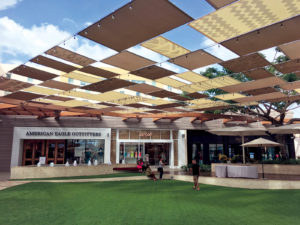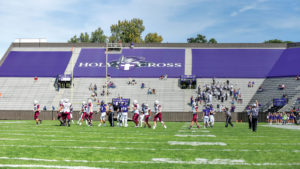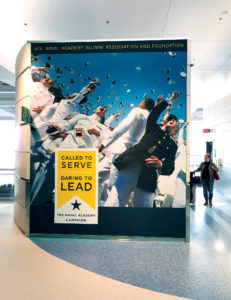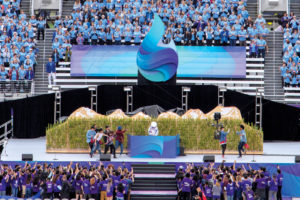
on fabric was with handheld umbrellas. Now the Honolulu company uses graphics for a wide array of applications, including shade panels for this shopping center. Photo: Tropical J’s Inc
Ron Nissenbaum, CEO of Humphrys CoverSports in Philadelphia, Pa., has been in the business long enough—51 years to be precise—to have witnessed a few changes in the way fabricators use graphics.
When Nissenbaum started at Humphrys, which itself is nearly 150 years old, graphics were a rarity on the tarps, sports field covers and other products the company produced. Windscreens, for example, were made primarily to protect tennis courts from the wind, not to deliver sponsor messages, according to Nissenbaum.
Today, graphics printed on fabric are ubiquitous in our world, whether on those windscreens, in office building lobbies or on hotel awnings, to name just a few applications. And as the graphics have become more sophisticated, so have the methods for producing them.
“When we started adding graphics back in the day before the digital revolution, you needed a sign painter,” Nissenbaum says. “That’s a business you don’t want to be in today—along with pay phones.”
The proliferation of graphics has led some fabricators to dip a toe into the market, or to at least consider making the jump. But for the uninitiated, establishing a graphics component in a fabrication business can seem daunting, requiring knowledge about a dizzying array of options. For this article, we talked to fabricators who have made graphics an integral part of their business and asked them to help make sense of it for those thinking about taking the leap.
Universal language

“Graphics are a universal language these days,” says Geoff Kilmer, founder and CEO of PhotoWorksGroup, Charlottesville, Va. Kilmer was an early adopter when it comes to using graphics on fabrics. With a background in photography, his company has focused on graphics treatments since the day it opened in 1986.
One of the big drivers of the graphics trend is the rise of “environmental graphic design,” or EGD, a term defined this way by the Society of Experiential Graphic Design, a Washington, D.C.-based nonprofit trade association:
“Environmental graphic design embraces many design disciplines including graphic, architectural, interior, landscape, and industrial design, all concerned with the visual aspects of wayfinding, communicating identity and information, and shaping the idea of creating experiences that connect people to place.”
The language is a bit buzzy, but anyone who has traveled through an airport, visited a museum or stopped at a receptionist’s desk lately has seen graphics displays that are considered EGD—even if they didn’t know that’s what they were seeing.
Emphasis on brand
To put a finer point on it, EGD is really an extension of a business emphasis on brand, the method by which companies define their image and culture, both outside the organization and within it, and differentiate themselves from their competition.
“Companies want a brand. That’s really the bottom line,” Nissenbaum says. “In sports, for example, they want a field that is first-class and looks sharp; that’s what attracts the players. Graphics can be the difference. It makes that field pop, as opposed to 20 years ago when all you had was a green windscreen.”
Like many other companies, PhotoWorksGroup had to tighten its belt during the recession of 2007–2009, losing about 40 percent of its recurring revenue. But while it may have been hard to find a silver lining from that difficult time, Kilmer says many companies came out of that period with a renewed emphasis on brand—which was good for his business.
“Clients were actually coming in with budgets for digital printing as part of their brand projects,” he says. “Today, it’s a new workforce, and they want to get across the company culture. They’re putting a lot more energy, effort and money into catering to people’s well-being and seeking their goodwill—much of which can be accomplished through graphics.”
The recession also enhanced Humphrys’ business, says Nissenbaum, as on-field advertising, which is often printed on those windscreens, became a source of revenue for cash-strapped school districts that had seen their budgets decrease as tax revenues declined.
Equipment choices
For whatever reason a customer wants graphics, the fabricator who is going to produce them needs to decide what printing process(es) and equipment is best suited to the work. There are many choices, and while the technology is not advancing as rapidly as it did a decade or two ago, equipment and the software required to run it does continue to evolve.
“The first thing is to really learn everything you possibly can about graphics,” Nissenbaum says. “Go to seminars, talk to machinery manufacturers. You have to understand this is all very sophisticated.”
Because investing in equipment can be something of a “leap of faith,” he says, “you want to think hard about how you go about that.”
“Identify your clients or who your prospects are, or what industry,” Kilmer says. “Know where you’re going to get your sales from. You’ll be in a better position to have work once you place your equipment.”
“Capital investment is a challenge to getting started,” says Jennie Day, manager of external communications for Rainier Industries Ltd. in Tukwila, Wash. “We added outdoor signage and graphics to our offerings in 1994, when we were a modest tent and awning company. Graphics was a natural fit with commercial awning manufacturing, but we’ve grown into the services we offer over 25 years.”
Humphrys started out by painting graphics by hand using stencils with a roller and ink on PVC mesh and solid fabrics. “Then, as our volume grew and the technology changed, we bought our first digital printer and then we bought others,” Nissenbaum says. “Now we have three and they’re worth $1.3 million.”
Partnering as an option

universal language these days,” says Geoff Kilmer, company founder and CEO. Photo: PhotoWorksGroup.
While some larger fabricators use a combination of processes, and can do everything in-house, companies just starting out in graphics may want to consider partnering with other companies for at least some of their graphics needs to avoid some of those equipment costs.
For example, Tropical J’s Inc., which produces shade and outdoor products in Honolulu, Hawaii, started out in the late 1980s putting colorful Hawaiian prints on handheld umbrellas. “Customers started asking if we could put those designs on outdoor umbrellas, so we taught ourselves how to silk-screen latex paints onto Glen Raven’s Sunbrella® fabrics,” says Jordan Barnes, the company’s director of design.
Back then, Barnes says, “Large-scale silk-screening and direct painting with stencils were a very big risk, and new printers were extremely expensive and very costly and time-consuming to maintain.”
So as the business progressed, the company chose to focus its in-house expertise on a graphic production process called eradication—using stencils as well as direct application of vinyl adhesives—while outsourcing other printing needs, eliminating the need to purchase those pricey printers.
“People can get into a ‘one step at a time’ mentality and not commit too much money to equipment,” Kilmer suggests. “To overcome this challenge, we recommend purchasing equipment in phases. Subcontract what you can’t handle until you have enough business to justify purchasing the right equipment.”
Local regulations

Before investing in graphics equipment and deciding what products to offer, fabricators should be aware of local regulations that can affect the scope of their work.
“In the greater Boston area, there are a lot of restrictions about signage; it’s pretty conservative,” says Cheryl Yennaco, owner and general manager of Atlantic Awning in Melrose, Mass. “It’s hard to do anything too crazy or fancy or colorful in our area.”
The same situation applies to Tropical J’s, which does much of its work in Waikiki. “It has its own governing body, the Waikiki Special District, and it has a fairly strict color approval process,” Barnes says.
In one way, doing graphics is no different from any other fabrication job—delivering the job to the customer on short order is critical. But using graphics can make the job more challenging.
“Amazon has raised the bar for everybody,” Nissenbaum says. “You can’t tell somebody four or five weeks these days. With college football championship games, for example, they don’t know who is playing until a week before. If you’re going to do banners and logos on sideline tarps, being able to do a job quickly is a big deal.”
Jeff Moravec is a freelance writer from Minneapolis, Minn.
 TEXTILES.ORG
TEXTILES.ORG


